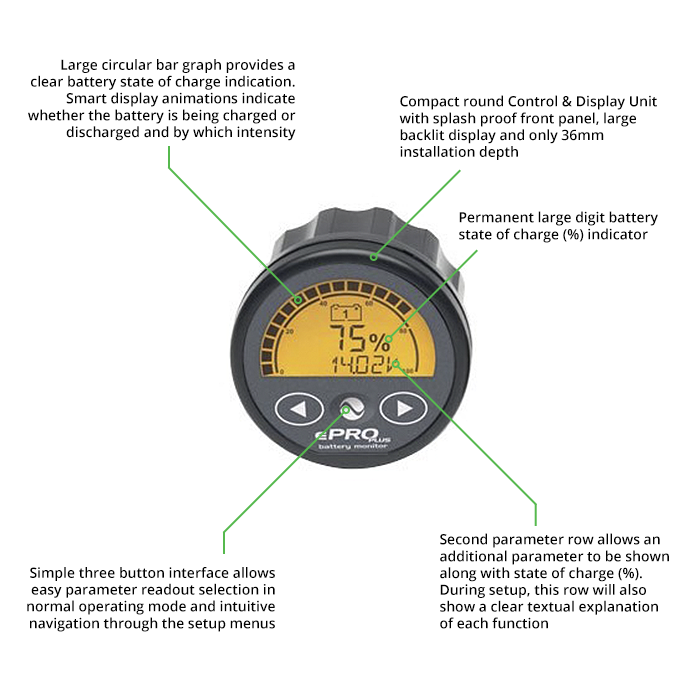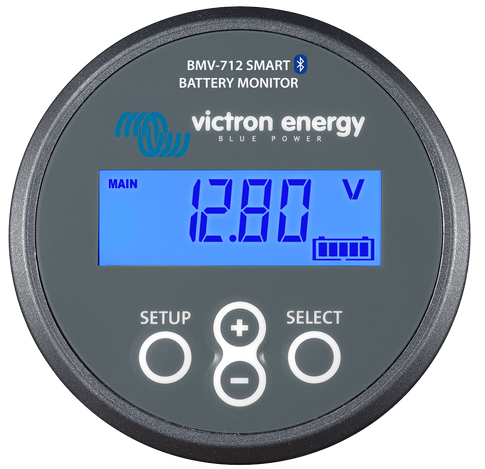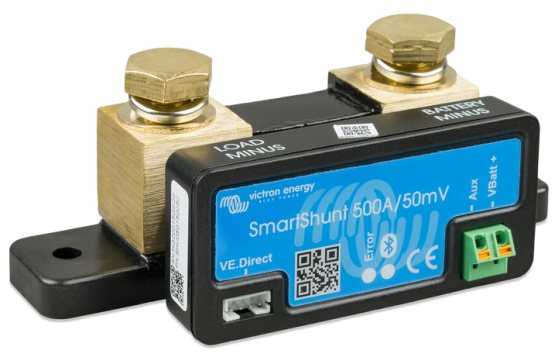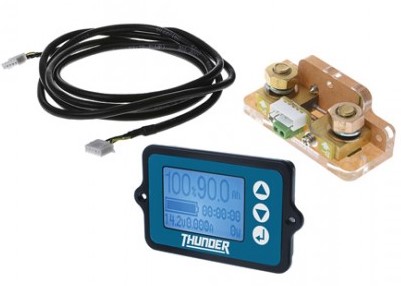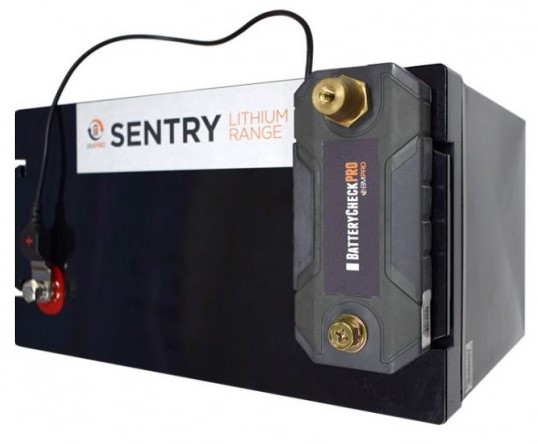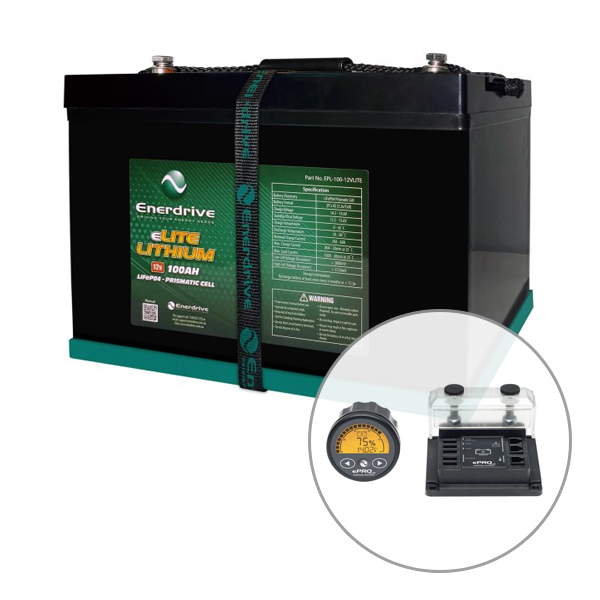Are you tracking your battery's performance? If you want to make sure your batteries are always running at top performance, you need a battery monitor.
Read on to find out how a battery monitor works and which battery monitor is best for your set up:
What Is A Battery Monitor?
A battery monitor is designed to connect to your battery and calculate Ampere hours consumed and the state of charge of a battery.
The number of Ampere hours consumed are calculated by integrating the current flowing in or out of your battery.
This allows you to monitor the state of your battery, discharge current, temperature of your battery, remaining battery capacity, time remaining of your battery bank, and more metrics. Plus, if any of the metrics are not normal, the battery monitor can also provide an alarm. For example, if the temperature is too high, an alarm will sound.
Why Do You Need A Battery Monitor?
A battery monitor is essential to keep tabs on your battery's health. You simply connect the monitor of your choice to your battery and track the important metrics you need.
With a battery monitor, you can understand how many amp-hours of power you've used, what charge condition your batteries are currently in and how much power you've been able to put back in with solar, when your batteries are topped off, and more.
The best part is, with many newer battery monitors, this information is all available in a handy app on your smartphone.
This information allows you to be much kinder to your batteries, which ultimately means they perform better and have a longer life.
For example, lead acid batteries like to be 100% charged every day. And if you can't do this, their lifespan will decrease. Without a battery monitor, it's hard to know what state they are in. With a battery monitor, you can see their state of charge and make sure it reaches the max.
Which Battery Monitor Brand?
Lots of battery brands offer battery monitors to make sure your battery is performing at its best. The most reputable brands are Enerdrive, Victron, Simarine and Baintech.
Compare the most popular battery monitor models:
Let's take a look at how the most popular models compare:
Enerdrive ePRO Plus:
Under $400, 500 Amps
Pros: The ePRO PLUS can monitor up to three battery banks, and the inputs for the second and third battery banks can also be configured for other purposes, such as mid-point voltage measurement, keyswitch input, setup lock or backlight control. You can also see the history of the battery including Average Discharge (AH and %), Deepest Discharge (AH and %), Total AH removed from battery, and Total AH charged to the battery.
Cons: It doesn't come with Bluetooth connectivity or temperature sensor as standard, but you can buy an Enerdrive ePRO Plus USB Bluetooth Dongle ($219) and Enerdrive ePRO Temperature Sensor Kit ($96).
Simarine By Enerdrive:
From $849, 300amps, (Shunt 300A)
Pros: The Simarine is highly versatile and lets you add up to 20 x Simarine shunts and modules so you can monitor up to 6 battery banks, 14 tanks, 10 temperatures, 20 independent consumer and generators, and one Inclinometer sensor with pitch and roll readings (i.e. slope and tilt). You also get a free app to connect your PICO display to your smartphone using Wi-Fi. With the apps, you can monitor all battery and tank data, upload history, edit and restore settings and even upgrade the firmware with new features. As a battery monitor, the Pico system gives you a simple overview of voltage, current,amp hours, battery capacity (%), and battery temperature.
Cons: It doesn't come cheap! Starting from $849, you pay for each of the modules separately.
Victron BMV-712 Smart:
Under $300, 500 Amps
Pros: Victron's smart BMV-712 battery monitor boasts all the features of the BMV-702 with the added benefit of Bluetooth connectivity. Monitor up to two batteries, with the additional input letting you measure the voltage of a second battery, temperature of midpoint voltage of the main battery.
The BMV-712 monitors a great range of metrics: Average Discharge (AH and %), Deepest Discharge (AH and %), Total AH removed from battery, and Total AH charged to the battery, highest and lowest battery voltage, number of days since the last full charge, number of full discharges (0%), number of charge cycles (below 65% and above 90%, and average discharge depth.
Cons: The temperature sensor doesn't come as standard, but you can buy the add-on Victron Temperature Sensor. However, when using the temperature sensor, the second battery voltage and midpoint voltage monitoring is not available.
Victron BMV-702:
Under $270, 500 Amps
Pros: If you want to measure your main battery plus a second battery, such as a starter battery, the BMV-702 is the Victron battery monitor of choice. It features all the same benefits as the BMV-712, without bluetooth connectivity.
Cons: Bluetooth connectivity doesn't come as standard, but you can purchase the Victron VE.Direct Bluetooth Smart Dongle ($85). The temperature sensor is also not built-in, but available with the add-on Victron Temperature Sensor. However, when using the temperature sensor, the second battery voltage and midpoint voltage monitoring is not available.
Victron BMV-700:
Under $230, 500 Amps
Pros: The Victron Battery Monitor BMV-700 is the entry level Victron battery monitor for one battery only. You can add Bluetooth connectivity with the Victron VE.Direct Bluetooth Smart Dongle ($85).
Cons: It doesn't come with an additional AUX input to measure voltage (of a second battery), temperature or midpoint voltage. It is not possible to measure temperature or buy an add-on accessory.
Victron Smart Shunts:
From $210, 500amp/1000amp/2000amp available
Pros: The SmartShunt is an all in one battery monitor, only without a display - your phone acts as the display. The SmartShunt connects using Bluetooth to the VictronConnect App on your phone or tablet, so you can read all monitored battery parameters, like state of charge, time to go, historical information and more. This makes it a great alternative for a BMV battery monitor, especially where battery monitoring is needed but less wiring and clutter is wanted. You can measure up to two batteries.
Cons: The temperature sensor doesn't come as standard, but you can buy the add-on Victron Temperature Sensor. Like the Victron BMV-712, when using the temperature sensor, the second battery voltage and midpoint voltage monitoring is not available.
Thunder Battery Monitor Display:
Under $115, 150 Amp
Pros: Thunder's Battery Monitor Display is easy to install and allows you to monitor basics such as your battery percentage, current draw, current inwards and wattage usage on one compact and easily accessible screen. It is designed to work with most 12 Volt Gel, Lead Acid, Lithium, AGM Deep Cycle, Lithium Ion phosphate and Calcium batteries. At $106, this is a good entry level option.
Cons: There's no option for Bluetooth connectivity or temperature sensor. You can only monitor one battery and cannot view the battery history.
BMPRO BatteryCheckPRO Wireless Battery Monitor:
Under $300, 240 Amp
Pros: The BMPRO BatteryCheckPRO is a smart wireless battery monitor that uses Bluetooth to provide data to a free smartphone app. It works with batteries in parallel (7Ah-800Ah battery bank). The monitor is designed for your secondary batteries, and allows monitoring up to 300A maximum charge or discharge. It is compatible with deep cycle lead acid, AGM, Gel and LiFePO4 batteries.
Cons: BatteryCheckPRO is not suitable with engine cranking applications of any type or for under vehicle bonnet use. However, you can use it on a ute tray application in a sealed battery box or in a marine application if the battery area is free from water and salt. It does not provide battery history.
BMPRO BatteryCheck100 Wireless Battery Monitor:
Under $250, 80 Amp
Pros: As with the BatteryCheckPRO, this is a smart wireless battery monitor. BatteryCheck100 is compatible with a range of standard 12V deep cycle batteries and provides real time battery management data via a smartphone app. Specially designed for recreational vehicles' deep cycle batteries, the BatteryCheck100 allows monitoring up to 100A maximum charge or discharge.
Cons: BatteryCheck100 is not suitable with engine cranking applications of any type and is not intended for under vehicle bonnet use. It does not provide battery history - only real-time monitoring.
The BatteryCheck100 and the BatteryCheckPRO are stand alone products that can be purchased on their own without the full suite of other BMPro equipment.
Other BMPro Monitors:
BMPro do offer a range of advanced battery monitor and display units for example:
These models will only operate inconjunction with specified BMPro battery management systems. You can compare all BMPro monitors here.
Pro Tip: We offer bundles that include batteries and battery monitors. Check out our range!
If you have any questions please don't hesitate to contact one of our product experts on 1300 400 122.

